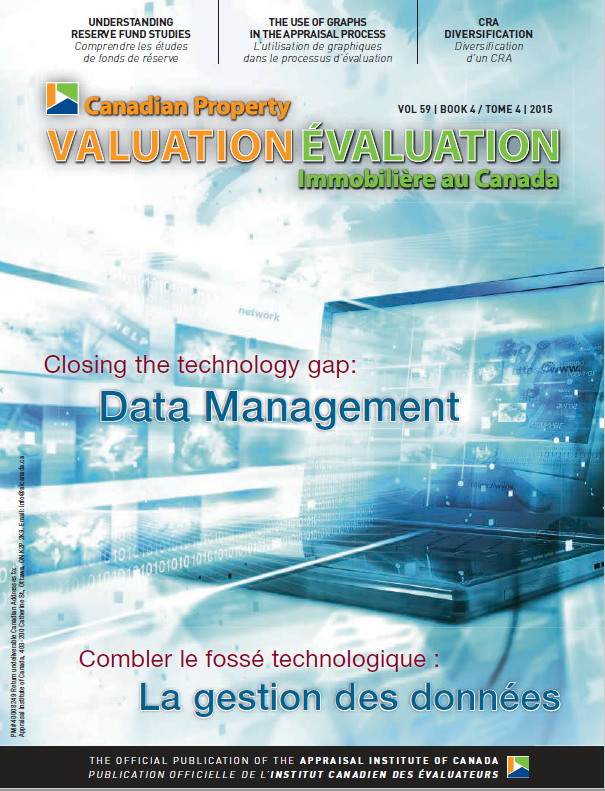CRA Diversification
Canadian Property Valuation Magazine
Search the Library Online
Here are some examples of how CRAs have successfully diversified their practice.

Kari Benum, CRA
Reserve fund studies
Kari Benum, CRA was fortunate to work for a large appraisal firm exploring a new line of business in reserve fund studies, also known as depreciation reports in British Columbia where they were legislated in 2011.
“Along with an AACI in the company, who had experience in this industry in another province, we launched into the business during a time when the legislated changes were very new,” says Kari.
How to begin to diversify
In 2012, Kari achieved her Certified Reserve Fund Planner (CRP) designation with the Real Estate Institute of Canada. With a strong background in new construction as a CRA, along with previous experience in the banking industry, the CRP courses were a natural fit.
“We began our local marketing approach based on preliminary contacts with strata/property managers. We created an online request form via our website to obtain a complimentary proposal/quote, which provided a more hands on request. We also found it beneficial to advertise our services within appraisal, real estate, and provincial homeowner association publications. Working for a well-recognized and respected firm helped in building early relationships with other professionals, as did networking within the business community. Branding my connection to another professional service was a priority. To establish ties with key strata management companies, we hosted an information meeting for strata managers early into our launch. As the relationships developed, we continued to speak at strata meetings to discuss our role as reserve fund planners. These connections rippled into ongoing relationships with self-managed strata corporations, realtors, mortgage brokers and mortgage insurers. We continue with these practices today and focus on opportunities to speak about the benefits of having a reserve study/depreciation report,” explains Kari.
As with most business success, referrals become a primary source of momentum in establishing a positive professional reputation. Kari had an opportunity to collaborate with two other reserve fund planners and present at the AIC National Conference in Kelowna in June 2015. Exposure to a variety of opportunities has created ongoing business prospects and confidence in the service provided.
Keys to success
Being aware of the requirements within CUSPAP is critical with all assignments. As Kari points out, “Most of the same professional practices apply to reserve fund studies as other types of appraisal and consulting assignments, with some additional expectations. The CRA scope of practice is unique when it refers to reserve fund studies. The Reserve Fund Planning Standard is acknowledged within CUSPAP 2014. Understanding individual provincial legislation is also imperative to remain compliant, not only with AIC standards and professional practice, but provincial regulation as well. Provinces vary from precise to rather vague when it comes to who is deemed ‘qualified’ to complete a reserve fund plan. While the AIC supports completing the assignment if the CRA has the ‘knowledge and experience to complete the assignment competently,’ not all provinces recognize a CRA as a qualified professional under their provincial legislation. In those provinces, it may be advantageous for a CRA to obtain a designation such as the CRP (Certified Reserve Fund Planner), while in others the new Program offered by UBC can provide a comparable educational background.”
The reasonable appraiser test applies to reserve fund planning at all levels. The most significant difference is that a CRA working in the capacity of the reserve fund planner is not restricted to four or less self-contained units, as many strata corporations are typically made up of significantly more units.
“Strata/condominium corporations vary considerably,” says Kari. “Becoming proficient at the workings of HVAC and mechanical systems and estimating their replacement cost, for instance, is very challenging, along with being up to date with the current legislation. I believe that having a well-versed mentor brings an endless opportunity to grow in this industry and become adept at appreciating the full scope of complexity with each assignment. Strata councils/condominium boards are made up of volunteers with diverse experiences and views. Managing these relationships in a professional, yet empathetic approach is vital. I have come to learn that money is emotional. Reserve fund plans can trigger a very sensitive response.”
A typical assignment
According to Kari, “A typical assignment involves preparing a proposal for a depreciation report, which outlines a variety of key aspects of the assignment including the scope and role of the planner, qualifications, what is included, fees, and timing. Once an assignment is approved, a full site review is completed for the development. All common areas are previewed including corridors, social rooms, washrooms, mechanical and utility rooms, elevator rooms, underground parking garages, decks and roofs (when accessible), building exteriors and site improvements, and any amenity areas such as pools or exercise rooms.
“Once each common element is accounted for, the quantification of each is completed, establishing an estimate of current and future replacement cost. In BC, a reserve fund planner must provide three financial models to assist the strata corporation with its long-term financial strategy. Similar to an appraisal, the findings are presented in a written report with supporting documentation. Some strata corporations request additional consultation to assist with explaining the findings of the reserve plan to the unit owners and strata manager. It is mandatory to update the reserve fund plan every three years in BC, while lengthier time between updates is required in some other parts of the country.
“Maintaining organization of all documents, managing inquiries from potential clients, preparing presentations and general administrative duties all form a daily routine for a reserve fund planner.”
How it differs from other valuation assignments
Although the professional expectations are consistent with an appraisal assignment, the outcome of the assignment is quite different says Kari. “The focus of a reserve fund plan is not on establishing an estimate of market value, it is on a long-term capital replacement cost strategy for common assets of the strata/condominium corporation.
“Terminology is unique to reserve fund planning as well. A reserve fund plan provides a benchmark analysis, cash flow projections, prudent recommendations for long-term reserve fund contributions, and reserve fund accumulation through reserve fund modeling. Provisions for interest and construction cost inflation are a key aspect of a well-defined plan, as the cash flow models projections are 25-30 years, contingent on the provincial standards. As many other terms are unique to reserve funds, defining these terms within the report may assist the clients in better understanding of the technical language. As noted, provincial legislative requirements are also distinctive on many levels. The planning advice may extend into council meetings and annual general meetings for the strata/condominium corporations.”
How diversification can benefit a CRA’s practice
“I have been able to make reserve fund planning the primary source of my practice with the support of my employer and mentor,” says Kari. “As with all aspects of my career, I believe the value-added approach to my relationships has developed a strong foundation, in turn, evolving my professional character. Reserve fund planning has provided a well-rounded approach to my career choice as an appraiser and gives me another set of tools in the toolbox.
“I truly enjoy working with people. Often, it is our very forensic nature that draws us into the appraisal profession. From building the relationship, being on site, and developing a resourceful approach to a critical long-term responsibility, I find the work creative. Each assignment offers a new council, new challenges and an opportunity to present logical guidelines for each strata to protect its long-term investment.”
Please note: Each jurisdiction recognizes different qualifications and designations that are required to complete Reserve Fund Studies. Be sure to review your province’s Condominium Act to confirm the required qualifications in your region.

Troy Davidson, CRA
Expropriation
“I have been involved in determining the value of property for expropriation purposes since I became a CRA in 1996,” says Troy Davidson, CRA. “It just happens to be the nature of the marketplace in what is a very rural region of Nova Scotia.”
Troy is the owner of Davidson Appraisals Limited in Wolfville, NS, where he practices his profession alongside his father John E. Davidson, who is also a CRA. In 2005, Troy bought the business from John who has been his trusted mentor since he first chose real estate appraisal as a career in 1992. A third CRA, a Candidate and a part-time administrative assistant are also part of the company that serves the valuation needs of the Annapolis Valley.
Why diversification is important
According to Troy, “In our rural setting, there are a number of highways that run throughout the valley and they are routinely undergoing some sort of expansion. When those changes involve twinning, encroachment or other property issues, our company is called upon by the Nova Scotia Department of Transportation and Infrastructure Renewal (formerly the Department of Transportation) to get involved in the expropriation process. Whether the situation involves vacant land or family dwellings, we are responsible for determining market value of the property and presenting it to the Department for its use in negotiating fair and equitable settlements with the property owners.”
Stressing that the expropriation work is very much tied into the government’s budget allocation at given points in time and hence somewhat sporadic, he is extremely proud of the fact that his company has a long-standing relationship with the government whenever expropriation work is required.
“It gives me a great deal of pride and satisfaction that a major government agency places that kind of trust in our services,” he proudly states. “It is definitely a pat on the back for our professionalism in getting the job done.”
How diversification can benefit a CRA’s practice
Troy points out that providing expropriation service to the government is good for business in other ways. “Whether for individual property owners or for other professionals in the financial or legal fields, such as public trustees calling on us to handle valuations for estate purposes, we are seen as a trusted company that can handle their valuation needs.
“Since we are CRAs, our work is always carried out according to the scope of practice regulations clearly outlined in the Canadian Uniform Standards of Professional Appraisal Practice (CUSPAP),” says Troy. “As such, we handle properties ranging from vacant land up to and including four-plexes. If a valuation is required for something more than that, we refer the job to AACIs in our geographic area and they refer to us. It works very well all around.”
How to begin to diversify
Having handled expropriation work for almost 20 years has instilled in Troy the confidence to deal with whatever unique situation comes his way. However, he also knows that continuing professional development is vital to the ongoing growth of his personal skills along with his business, and he enthusiastically takes CPD courses on subjects such as partial takings and expropriation whenever he can.
“Earning the annual credits to meet AIC requirements is part of it,” says Troy, “but staying current with the latest techniques and trends is even more important.”
In addition to the CPD courses, Troy also hones his skills through volunteer services to the profession. For four years, he served on the AIC’s national Applied Experience Committee and, for the past decade, has been a member of the Committee of Examiners for the Nova Scotia Real Estate Appraisers Association.
“I look at it all as being vital to my professional development,” he says. “It enhances my knowledge and skill as an appraiser so that I can provide my clients with the best possible service no matter what the circumstances. In addition to bank refinance appraisals, we also do litigation assignments for division of matrimonial property, preparation for expert testimony, estate assignments, resale, new construction, etc.”
Key to success
“I never viewed the CRA designation as being restrictive in any way,” says Troy. “Earning that designation requires a great deal of hard work and I am extremely proud of the professional service it enables me to provide. Expropriation work is out there and CRAs certainly have the capacity to undertake the work provided the properties fall within the designated scope of practice.”

Deana Halladay, CRA
Divorce/family litigation and estate planning
For Deana Halladay, CRA, owner of Winnipeg’s Halladay Appraisal Services Ltd., expanding her services beyond mortgage financing assignments was a natural progression brought about by a rapidly changing marketplace.
Why diversification is important
“Like many CRAs, mortgage work was our bread and butter,” says Deana. “However, the fees we charged were being driven even lower with the advent of appraisal management companies and the change in lender business models where the outsourcing of appraisal services became the new reality. That was 15 years ago, and it was obvious to me that something had to change.”
Up for the challenge, Deana decided that she needed to take on more complex appraisal assignments where there was less competition and where higher fees could be charged due to the complexity of the work. Matrimonial settlement and litigation as well as estate planning were two specialties that became a natural progression.
According to Deana, “I knew that the scope of practice for a CRA under CUSPAP regulations allowed for consulting and review work, as long as the residential properties involved are no larger than four dwelling units. The opportunities seemed endless.
How to begin diversifying
To refine her skills in these more complex service areas, Deana took report writing and communication courses, attended seminars on preparing for expert witness testimony, participated in mock trial presentations and worked at honing her presentation skills in order to become comfortable defending her work when required.”
Deanna immediately began advertising her expanded services in venues like telephone and legal directories and also set up a website that, to this day, is vital to growing her business. Believing that her reports were her main marketing tool, she focused on making them well researched, written and documented, so that the quality of the work would speak for itself. It most certainly did.
“The majority of my business comes from referrals,” she states with the pride of a true professional.
How it differs from other valuation assignments
“Preparing a report for mortgage purposes with a bank is far different from preparing a report where litigation is involved,” says Deana. “If you are going to charge higher fees, which this type of work warrants, you need to provide much more information that can be fully supported and defended. CUSPAP stresses the need to analyze and detail your work, and it is a philosophy to which I am completely committed.”
To ensure that her reports have the best chance of meeting the needs for which they are intended (which can be quite complex where divorce/family litigation and estate planning are concerned), Deana knew she needed to thoroughly understand each assignment’s unique situation.
“Communicating and asking questions is absolutely critical,” she says. “Sometimes people know they need an appraisal or it has been suggested that they get one, but they are not sure why. I certainly do not give legal advice, but I try to guide my clients through the process so that they understand why an appraisal is so important and how it will benefit them. Asking lots of questions right up front also helps me to get a better feel for the work that will be involved and to establish an appropriate fee, which is always a challenge.”
Keys to success
Helping Deana’s business flourish has been the fact that other professions are increasingly realizing the need for and the value of a well-done appraisal. Deana points out that more and more, “lawyers, accountants, and organizations such as the Canada Revenue Agency are recommending or asking that professional appraisals be conducted. Thorough and detailed appraisals can provide base line values for divorce or estate settlements and can diminish the risk of liability. In the grand scheme of things, a comprehensive, professional appraisal is an invaluable independent opinion. One of the AIC’s objectives has been to promote the services of its members and it appears as though the message is being heard.”
How diversification can benefit a CRA’s practice
Deana’s success demonstrates that a diversified practice can bring opportunities for CRAs to expand their range of services and be paid accordingly for the work they do.
“Business is good,” she says. “My hard cost per job is less, my fees are significantly higher, I get to pick and choose my assignments, I deal in longer timelines compared to other types of work that command shorter turnaround times, and I get to meet a lot of interesting people. Oh yes, and I get to spend more time with my family. It has definitely worked out well.”
Diversification of one’s practice is both a personal and business decision. Litigation is not for everyone, nor does every market present the same opportunities to expand one’s scope of practice. That being said, Deana encourages CRA members to look at their skills and knowledge and explore the opportunities within their markets.
“If you have the interest and the desire, there are plenty of people out there willing to help you expand your horizons, myself included.” she says encouragingly.





